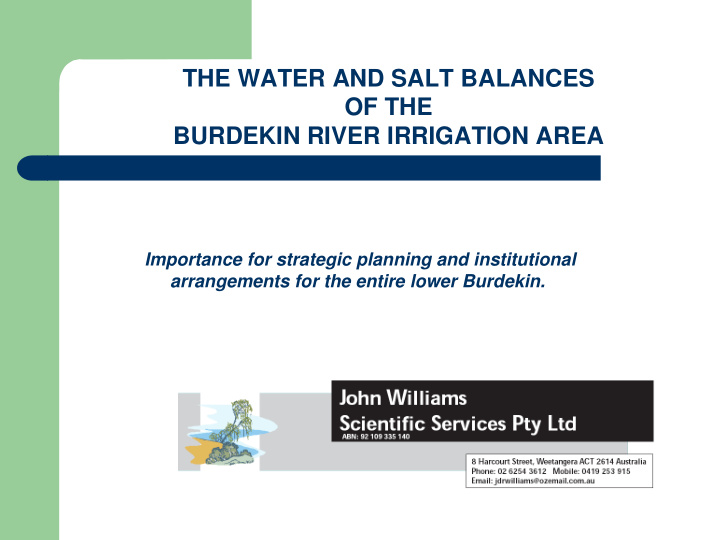



THE WATER AND SALT BALANCES OF THE BURDEKIN RIVER IRRIGATION AREA Importance for strategic planning and institutional arrangements for the entire lower Burdekin.
Issues Two issues to be managed: � Rising groundwater levels � Salt concentrations in groundwater
Points to remember Sustainable management of the groundwater of the lower Burdekin will be achieved through a mix of four mechanisms � Deep drainage to remove saline groundwater � Pumping of groundwater for irrigation � Improved irrigation practices to reduce leakage beneath root zone � Reduced channel leakage Strategic planning, policy and pricing will need to be converged to get the right mix
Starting point � Project began in May 2007 � First stage Document of Discovery ‐ talking to stakeholders ‐ reviewing the science ‐ bringing together a snapshot � Key findings ‐ a lot of science but no big picture ‐ stakeholders working in different directions ‐ issues important for whole lower Burdekin
How to move forward � All stakeholders need to undertake a strategic planning process together to map out way forward � Before this process can start people needed to have a feel for the problem ‐ how big is it? ‐ what is contributing to it? ‐ what else do we need to know? � With these things broadly quantified the next step of the process can begin
Contributors ‐ irrigation Leakage to groundwater 48 – 455 mm/year Discharge to sea 2 – 20 mm/year It is much easier to add water to the groundwater system than drain it to the sea
Contributors – irrigation 0.4 to 4.0 23 to 225 Drainage beneath Woodland Drainage beneath irrigation is is~2 to 20 mm/yr ~50 to 500 mm/yr Gl/yr Gl/yr Drainage to sea ~2 to 20 mm/yr 1.5 to 15 Water table Gl/yr
Contributors ‐ irrigation Leakage Leakage Area of Total area Landscape Water leaking Water in beneath beneath irrigation drainage to excess to (ha) irrigation woodland capacity groundwater landscape (ha) capacity (mm per year) (mm per year) (ML) (ML) (ML) 100 12 45,000 63,000 15,000 47,000 32,000 200 12 45,000 63,000 15,000 92,000 77,000 400 12 45,000 63,000 15,000 182,000 167,000
Contributors ‐ irrigation Leakage beneath Water excess to Estimated rise in irrigation landscape capacity watertable (mm per year) (ML) (mm per year) 100 32,000 508 200 78,000 1,230 400 167,000 2,650
Groundwater rise
Contribution channel leakage System K=1 mm/day K=5 mm/day K=10 mm/day K=100 mm/day Haughton 0.18 0.90 1.81 18.08 Barratta 0.12 0.58 1.17 11.71 Total (GL/yr) 0.30 1.48 2.98 29.79
Combined leakage � However SunWater figures estimate is 67.6 GL/year � This channel leakage input combined with the irrigation leakage means: ‐ 160 GL/year entering the landscape ‐ 15 GL/year can naturally drain ‐ 145 GL/year addition to landscape � This would give double the rise in observed groundwater levels – water is escaping from the system � But where – what is the relationship and connections with the aquifers of Burdekin delta irrigation district?
Watertable rise BHWSS 3500 0 Electrical Conductivity (uS/cm) and Rainfall (mm) . -2 Water Level 3000 Conductivity -4 Rainfall (mm) 2500 -6 Water Level (m) -8 2000 -10 1500 -12 -14 1000 -16 500 -18 0 -20 72 73 74 75 76 77 78 79 80 81 82 83 84 85 86 87 88 89 90 91 92 93 94 95 96 97 98 99 00 01 02 03 04 05 06 07
Sodic/Saline soils
Sodic/Saline soils Sodic Soils Ameliorated Sodic Soils Rain Irrigation Rain Irrigation Runoff Runoff Leaching Leaching Intercept/ drain Recharge to groundwater Recharge to groundwater
Relationship of salt and groundwater BHWSS 3500 0 Electrical Conductivity (uS/cm) and Rainfall (mm) . -2 Water Level 3000 Conductivity -4 Rainfall (mm) 2500 -6 Water Level (m) -8 2000 -10 1500 -12 -14 1000 -16 500 -18 0 -20 72 73 74 75 76 77 78 79 80 81 82 83 84 85 86 87 88 89 90 91 92 93 94 95 96 97 98 99 00 01 02 03 04 05 06 07
What are the options? Re-use for Dispose excess water irrigation and salt in accord with if EPA specifications salinity suitable Intercept pump drain 48 - 435 mm/yr Leakage beneath Irrigation 50 to 455 mm/yr Drainage from landscape 2 to 20 mm/yr WATERTABLE
Where to from here? � All stakeholders feel they know the way forward � Need to share that vision and agree � Need to work together to develop knowledge to fill gaps in the picture � Need to work together to develop a Strategic Plan for how to achieve the vision using the options available � Plan must contain targets and actions which all stakeholders agree with � All stakeholders must combine their efforts to deliver the Plan
Timelines � This may take some time: ‐ it took 20 years to make the mess ‐ important to get the planning right ‐ some old wounds that may take some time � May need an interim set of criteria for any project undertaken before the Plan is complete � Any projects must be able to show they are reducing recharge or removing water/salt � Cost benefit assessment done to determine which projects deliver the best value for money
Any questions or suggestions?
Recommend
More recommend